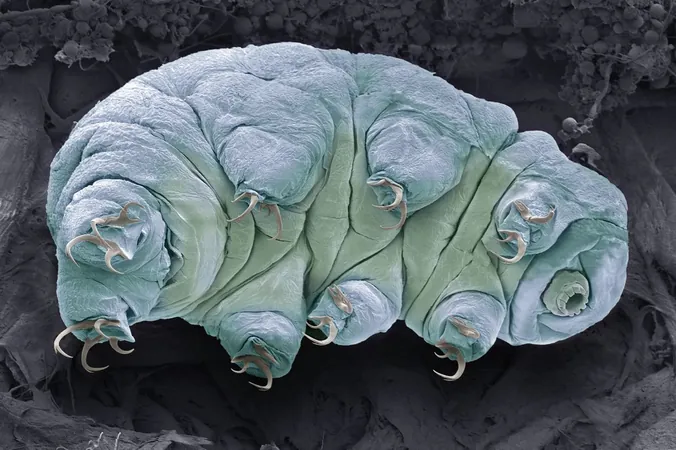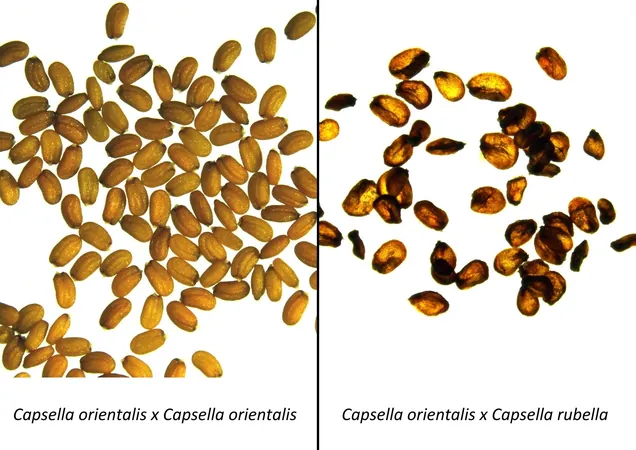
Tardigrades: Nature's Resilient Microscopic Superstars Could Be Key to Astronaut Survival in Space!
2024-11-07
Author: William
Introduction to Tardigrades
Tardigrades, often dubbed the "water bears" or "moss piglets," are microscopic marvels known for their astonishing ability to withstand extreme environmental conditions. These resilient creatures can survive without food or water for decades, endure lethal levels of radiation, extreme temperatures, and even the vacuum of space itself.
Recent Research Breakthroughs
Recent breakthroughs in research are shedding light on their remarkable resilience. A team of Chinese scientists has discovered a brand new species of tardigrades, named *Hypsibius henanensis*, after conducting studies in Henan province. These tardigrades harbor thousands of unique genes that activate in response to radiation exposure, suggesting a sophisticated defense mechanism that protects their DNA from damage caused by radiation. The implications of this discovery are monumental — researchers believe it could lead to improved protection protocols for astronauts on long missions, enabling safer exploration deeper into the cosmos.
Genetic Insights
In a groundbreaking paper published in the journal *Science*, the study highlights that this new species was subjected to radiation levels far exceeding what any human could endure. Remarkably, 2,801 genes associated with crucial biological processes—such as DNA repair, immune response, and hormone metabolism—were activated in response to such intense irradiation.
Role of DODA1 Gene
One standout gene, named DODA1, plays a vital role in this resistance. It enables tardigrades to produce antioxidant pigments called betalains, which help neutralize the harmful reactive oxygen species generated by radiation exposure. Notably, when human cells were treated with these tardigrade betalains, they demonstrated a significantly higher survival rate compared to untreated cells, implying potential applications in cancer therapies and protective treatments for humans.
Tardigrades in Space Exploration
The exploits of tardigrades in space have long captivated scientists. In 2007, they became the first animals to survive exposure to outer space when they were sent aboard a Russian capsule. Remarkably, 68% of them survived the harsh conditions and even gave birth to healthy offspring. This resilience was again showcased during the final mission of NASA's space shuttle Endeavour in 2011.
Unexpected Moon Adventure
In a rather intriguing incident, thousands of tardigrades were accidentally released on the Moon's surface when Israel's Beresheet spacecraft crash-landed. Though thoughts of them colonizing the Moon sparked ethical debates, experts deem the chances of survival there extremely low due to the lack of water and oxygen.
Continued Research in Space
Most recently, in 2021, tardigrades returned to space for extended research aboard the International Space Station. Scientists aim to unravel the mysteries of what adaptations these creatures employ to survive such extreme conditions and whether their offspring exhibit similar or altered 'tricks' for survival over generations.
Cryptobiosis: Nature's Survival Strategy
To cope with life's challenges, tardigrades can enter a state known as cryptobiosis, where they drastically reduce their metabolic activity, lose most of their body water, and shrivel to half their usual size. Upon rehydration, they swiftly bounce back to life, regaining their normal size and vigor in just half an hour!
Conclusion
As researchers continue to unlock the genetic secrets of these fascinating creatures, who knows what incredible applications might arise? From enhancing human resilience against radiation to advancing our space exploration capabilities, the tiny tardigrade could very well be the key to thriving beyond our planet! Stay tuned, as these findings could change the course of space travel forever!









 Brasil (PT)
Brasil (PT)
 Canada (EN)
Canada (EN)
 Chile (ES)
Chile (ES)
 España (ES)
España (ES)
 France (FR)
France (FR)
 Hong Kong (EN)
Hong Kong (EN)
 Italia (IT)
Italia (IT)
 日本 (JA)
日本 (JA)
 Magyarország (HU)
Magyarország (HU)
 Norge (NO)
Norge (NO)
 Polska (PL)
Polska (PL)
 Schweiz (DE)
Schweiz (DE)
 Singapore (EN)
Singapore (EN)
 Sverige (SV)
Sverige (SV)
 Suomi (FI)
Suomi (FI)
 Türkiye (TR)
Türkiye (TR)